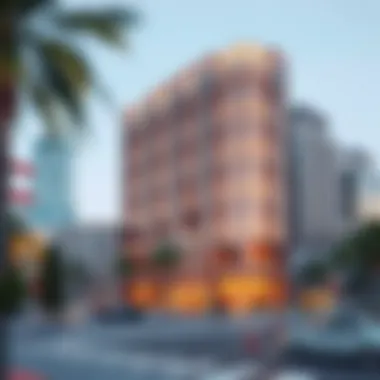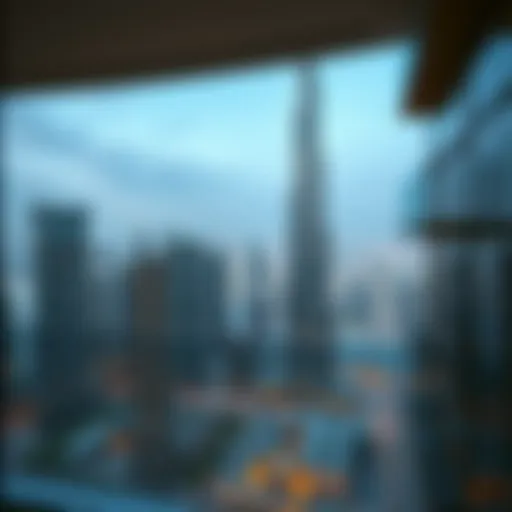Amir Building: Architecture and Landscape Insights


Intro
Amir Building stands as a testament to modern architecture, seamlessly blending functionality with aesthetic appeal. Located in the bustling heart of Dubai, this structure is not just a place for work or living; it embodies the cultural ethos of the region. By exploring the architectural significance and landscaping of Amir Building, we can appreciate how it contributes to urban development and landscape artistry. This analysis will cover various aspects of the building—from its design elements to its impact on community life—providing a thorough exploration for stakeholders, whether they be homeowners, visitors, planners, or architects.
Neighborhood Features
Landscaping Highlights
The landscape surrounding Amir Building is crafted with meticulous care, showcasing a fusion of native plants and modern landscaping techniques. The incorporation of green spaces, such as community gardens and vertical green walls, demonstrates a commitment to sustainability. These areas not only enhance the visual appeal of the neighborhood but also provide a tranquil space for residents and visitors alike.
- Diversity of Flora: The use of local species helps conserve water and supports the regional ecosystem.
- Innovative Design: Water features, like small fountains and artificial ponds, add to the serene environment while also serving as cooling elements in the arid climate.
- Social Spaces: Benches and walkways encourage community interaction, turning the area into a social hub.
Architectural Styles
The architectural design of Amir Building reflects a blend of contemporary and traditional styles, symbolizing the dynamic growth of Dubai. This hybrid style incorporates:
- Glass Facades: These not only enhance the structure's modern aesthetic but also promote energy efficiency by optimizing natural light.
- Geometric Patterns: Inspired by local art, the building showcases intricate motifs that pay homage to Emirati culture.
- Sustainable Materials: The use of recycled and eco-friendly materials sets a benchmark for future developments in the area.
"Amir Building is a reflection of both the past and future, demonstrating how architecture can tell a story while addressing modern needs."
Community Life
Local Events and Activities
Community engagement is a vital aspect of the Amir Building neighborhood. Various events throughout the year foster connections among residents. These include:
- Cultural Festivals: Celebrating local traditions and art, these gatherings not only entertain but educate residents and visitors about Emirati heritage.
- Wellness Programs: Yoga sessions and fitness workshops attract health-conscious individuals, helping to build a vibrant community focused on well-being.
- Market Days: Local artisans showcase their crafts, supporting small businesses while enhancing community bonds.
Lifestyle Amenities
Living near Amir Building means enjoying access to a range of lifestyle amenities, making it an enticing choice for potential residents. Noteworthy amenities include:
- Cafes and Restaurants: A mix of international and local dining options caters to diverse tastes, allowing for a rich culinary experience.
- Fitness Centers: Well-equipped facilities encourage an active lifestyle, catering to residents of all ages.
- Public Transport: The neighborhood is well-connected, offering easy access to key areas in Dubai, which is essential for residents commuting to work or leisure activities.
For more insights on urban development and landscape architecture, visit Britannica.
To stay updated on local events, check Facebook.
For additional resources on architecture, refer to Wikipedia and Reddit.
Prelude to Amir Building
The Amir Building stands as a testament to the dynamic architectural landscape of Dubai, representing not just a structure, but an ongoing narrative of culture, innovation, and urban evolution. This section serves as a cornerstone for understanding the implications and significance of this building within the larger context of urban development and architectural trends in the region.
Historical Background
To truly grasp the essence of the Amir Building, one must first peel back the layers of its historical context. Constructed in the early 2000s, the building emerged during a period where Dubai was rapidly transforming into a global city. The decision to erect such an iconic structure correlates with a broader ambition of the city to redefine itself as a hub for business, tourism, and cultural exchange.
The architectural style draws from various influences, merging modern aesthetics with traditional elements. For instance, the facade features intricate designs that pay homage to local traditions while embracing contemporary materials and techniques. This blend not only showcases the architectural prowess of the designers but also reflects the aspirations of a society eager to honor its roots while looking toward the future.


Purpose and Significance
The purpose of the Amir Building extends far beyond its physical space; it serves multiple functions that contribute significantly to the urban fabric of Dubai. First and foremost, it acts as a functional space for commerce and community events, facilitating a vibrant social atmosphere that attracts both locals and visitors. This engagement fosters a sense of community, encouraging social interactions that were once scarce in the fast-paced, sprawling metropolis.
Moreover, the significance of Amir Building transcends its role as an architectural piece. It symbolizes the city’s commitment to sustainability and innovation in urban planning. Green technologies integrated into the design highlight the prevalent concerns for environmental stewardship, which are increasingly critical in today’s architectural discourse. By embracing eco-friendly practices, the building not only enhances the urban landscape but also sets a standard for future developments in Dubai.
The Amir Building thus encapsulates a blend of historical resonance and forward-thinking architectural strategies, establishing itself as not just a building, but an integral part of Dubai’s identity in the 21st century.
Architectural Features of Amir Building
The architectural features of the Amir Building play a pivotal role in its identity and function, serving not only as a visual marvel but also as a benchmark of innovative design within the urban context of Dubai. This section dissects the intricate elements that comprise the building's architecture, illustrating how these contribute to both its aesthetic appeal and practical utility.
Design Philosophy
At the core of the Amir Building's architectural essence lies a design philosophy rooted in harmonious bridging of tradition and modernity. The creators infused elements that reflect cultural heritage while embracing contemporary architectural trends. This blend is reflected in the building's flowing lines and geometric patterns, invoking a sense of fluidity reminiscent of Dubai’s natural landscapes.
The design doesn’t just prioritize visual allure; it symbolizes the interconnection between form and function. Natural light is meticulously harnessed through expansive glass facades, which create an inviting atmosphere while significantly reducing the reliance on artificial lighting. This approach aligns with the broader principles of sustainable architecture, making it align with modern environmental standards and practices.
Structural Innovation
Amir Building is not just another skyscraper; it stands tall as a paragon of structural innovation. The use of cutting-edge technology in its construction has allowed for greater heights and spans without compromising safety or durability. It effectively utilizes a core and shell structural system that enhances stability, ensuring that it can withstand the fluctuating climatic conditions of the region.
Moreover, the incorporation of wind-resistant features is noteworthy. This minimizes discomfort for occupants and protects the structure over its lifetime. The use of modular construction techniques can also be highlighted, providing a level of efficiency that reduces the overall impact on the environment during the building process. These innovations culminate in a structure that isn’t just built—it's engineered for the future.
Material Selection
The choice of materials in the Amir Building reflects a conscious decision to balance elegance with sustainability. Glass, steel, and locally sourced stones were selected not merely for their durability but for their ability to resonate with the surrounding landscape. The reflective properties of the glass facades create a fascinating interplay with daylight, creating a shifting visual experience throughout the day.
Additionally, the incorporation of green materials, like recycled aluminum and low-VOC (volatile organic compounds) finishes, exemplifies a commitment to reducing environmental impact. Each material serves a function but also tells a story of environmental consciousness and aesthetic consideration.
In essence, the architectural features of Amir Building encapsulate a meticulous blend of thoughtful design, innovation, and material intelligence, establishing it as a significant landmark in Dubai. It stands not just as a place of work or leisure but as a testament to the evolving narrative of architectural excellence in urban development.
Landscaping Elements Surrounding Amir Building
The landscaping elements surrounding the Amir Building play a vital role in enhancing both its aesthetic appeal and environmental impact. These elements are not just decorative; they encapsulate a thoughtful approach towards harmony between the built environment and nature. From the choice of flora to the layout of green spaces, each aspect contributes significantly to the overall experience of the building and its surroundings.
Integration with Nature
Nature’s integration into urban landscapes can often feel like a daunting task, particularly in sprawling cities like Dubai. Nevertheless, the Amir Building is a testament to how landscapes can encapsulate natural beauty within a man-made structure. The strategical planting of native vegetation not only enhances biodiversity but also strengthens the building's relationship with its environment.
For instance, diversified plant life allows for a vibrant tapestry of colors and textures, which changes with the seasons. This ongoing transformation keeps the surroundings lively and engaging. Furthermore, the thoughtful placement of trees can create shaded areas, providing refuge from the sun's serious heat. Little details, such as water features, subtly mimic natural settings and can invite local wildlife, making the area feel less urban and more organic.
Green Spaces and Parks
Green spaces and parks surrounding the Amir Building are paramount to the community's well-being. Not only do they serve as recreational areas for families and visitors alike, but they also offer vital ecological benefits. Local ecosystems thrive in areas designed with flora and fauna in mind, facilitating an exchange between humans and nature.
Visitors to these parks can enjoy:
- Walking and jogging paths that promote outdoor activity.
- Play areas for children that encourage physical play and social interaction.
- Picnic spots that foster community engagement and leisure.


Creating spaces where people can relax, unwind, and converse provides a quality of life that often gets overshadowed by the rapid pace of urban development. It cultivates a sense of belonging, making the Amir Building not just a landmark, but also a lively community hub.
Sustainability Practices
Sustainability practices stand at the forefront of modern landscaping design, and the Amir Building’s surrounding landscape is no exception. Practices like xeriscaping, native planting, and efficient irrigation systems reflect a commitment to environmental stewardship.
A few exemplary methods include:
- Use of native plants that require minimal irrigation. This ongoing practice not only conserves water but also supports local wildlife.
- Rain gardens that capture and filter runoff, reducing pollution and promoting groundwater recharge.
- Composting and organic mulching that enrich the soil health, minimizing the need for chemical fertilizers.
Through these tailored initiatives, the surrounding landscape of the Amir Building demonstrates a blend of practicality, education, and responsibility towards ecological balance.
"Thoughtful landscaping not only complements architectural aesthetics but also contributes invaluable ecological benefits."
Community Impact of Amir Building
The Amir Building does not merely stand as an edifice of architectural prowess; it serves as a vital nexus in the community fabric of Dubai. Its impact can be examined through three key lenses: cultural significance, social engagement, and economic contributions, all of which underscore the centrality of the building in enhancing the quality of life within the urban landscape.
Cultural Significance
From its inception, the Amir Building has been a focal point for cultural activities, incorporating elements that resonate with the rich heritage of Dubai. It is not just a physical structure but a canvas showcasing local art and traditions. The architecture pays homage to Islamic design principles while blending modern aesthetics, creating a dialogue between the past and the present.
Cultural events hosted at the Amir Building, such as art exhibitions and local festivals, have fostered a sense of belonging among residents. Visitors and locals alike gather to celebrate their shared identity, making it a melting pot of cultural exchange. As a hub for creativity, it amplifies voices of local artists and provides a platform for cultural dialogue.
"Art is the most beautiful of all lies — that’s why Dubai thrives on showcasing its diverse cultural identity in places like the Amir Building."
Social Engagement
The Amir Building promotes social engagement by creating spaces conducive to community gatherings and social interactions. Its design includes parks, open plazas, and communal areas that encourage residents to meet, collaborate, and share ideas. These elements are crucial in a bustling city like Dubai, where the pace of life can often lead to isolation.
Moreover, initiatives organized by local stakeholders within the building's vicinity aim to include marginalized groups, thereby breaking down social barriers. Workshops, community classes, and discussion forums provide residents with the means to participate actively in shaping community norms and enhancing civic discourse. This social investment strengthens community ties and fosters a collaborative spirit among individuals of varied backgrounds.
Economic Contributions
The economic impact of the Amir Building cannot be overstated. As a landmark, it attracts both tourists and business investments, driving local commerce. The vicinity buzzes with cafés, restaurants, and shops that cater to the influx of visitors, leading to job creation and increased revenue for small businesses. Local artisans and vendors benefit from the traffic generated by events hosted at the building.
Furthermore, the Amir Building's architectural appeal has prompted real estate interest, leading to investments in surrounding properties. This, in turn, boosts property values and encourages urban development, creating a ripple effect that uplifts the entire neighborhood.
In summary, the Amir Building is much more than an architectural landmark; its influence permeates the community, enriching cultural identity, fostering social connectivity, and driving economic growth. It exemplifies the potential of architecture to integrate into and enhance urban life, representing a model for future developments in Dubai.
Comparative Analysis with Other Buildings in Dubai
Comparative analysis of Amir Building with other structures in Dubai serves as a pivotal exploration of how architectural design and urban functionality evolve over time. Such analysis not only spotlights the unique features of the Amir Building but also places it within the broader context of Dubai's rapidly changing skyline. By examining similarities and differences, we can gain insights into design philosophies, innovative approaches to function, and the cultural narratives that these buildings represent.
Style Comparisons
When we talk about architectural styles in Dubai, we are looking at a melting pot of influences that range from ultra-modern to historically inspired designs. The Amir Building stands out due to its distinctive blend of contemporary and traditional elements.
- Modern Aesthetic: With sleek lines and a glass façade, it reflects modernity. In contrast, buildings like the Burj Khalifa showcase a more avant-garde approach with its intrinsic design that pierces the sky.
- Cultural Echoes: The Amir Building resonates with regional architectural styles by using local materials and motifs that pay homage to its heritage. For instance, in nearby structures such as the Dubai Opera, we see a curved silhouette reminiscent of traditional dhow boats, a stylistic aspect less present in Amir’s square and streamlined approach.
- Blending with Environment: Notably, the integration of landscaping in Amir Building allows it to coexist harmoniously with places like the Dubai Marina, where you find high-rise towers nestling beside serene waterways. Such contrasts in landscaping techniques can evoke a richness that bolsters the urban environment.


This comparison delineates a spectrum where Amir Building's design draws on modern trends yet respects its geographical context. As a result, it becomes a point of reference for upcoming projects aiming for a similar aesthetic balance.
Functional Differences
Functionality in architecture goes beyond aesthetics; it directly affects the experience of users and surrounds. Here, Amir Building takes a distinct path compared to other prominent structures in Dubai.
- Mixed-Use Purpose: Amir Building often functions as a mixed-use space, housing offices, and retail outlets, thus serving a dual purpose. Other iconic buildings like the Dubai Mall focus primarily on commercial use, which creates heavy foot traffic without residential integration. This mixed-use approach fosters a sense of community, as visitors can dine or shop right next to business hubs.
- Innovative Layout: Layout innovations within Amir Building cater to both productivity and leisure. Spaces are designed not just to be functional but to foster interactions. This contrasts sharply with the rigid floor plans often seen in traditional commercial skyscrapers, allowing the Amir Building to breathe more vitality into its environment.
- Adaptable Spaces: Amir Building also emphasizes versatility in its indoor areas. Unlike fixed-purpose venues like the Emirates Towers, which are confined to office space, it can easily transition between events or pop-up shops, which adapt to the community's needs over time.
In summary, the comparative analysis of Amir Building against other notable structures in Dubai emphasizes its unique architectural syntax and functional adaptability. By understanding these differences, whether in style or functionality, we gain a deeper appreciation for the ongoing evolution of urban landscapes within Dubai.
"In architecture, the important thing is not the style but the character defined by the context it inhabits."
For more insights on Dubai's architecture, check out Wikipedia and Britannica.
Future Developments and Urban Planning
The future of the Amir Building entails a dynamic interplay of urban planning that aims to enhance its architectural significance while ensuring it meets the evolving needs of the community. The spotlight on future developments is crucial, as it directly impacts local economy, environmental sustainability, and overall lifestyle quality for residents and visitors alike. The integration of innovative designs and thoughtful urban strategies offers a promising path forward for this landmark.
Proposed Expansion Plans
The proposed expansion plans for Amir Building focus on creating a space that not only accommodates an increasing number of visitors but also enhances functionality without compromising on aesthetics. These plans include:
- Vertical Expansion: There is talk of adding additional floors that will house a mixed-use space combining retail, offices, and leisure facilities. This could elevate the building’s role as a hub of activity.
- Enhanced Amenities: The introduction of amenities such as rooftop gardens, observation decks, and interactive public spaces aims to offer more than just a physical structure, contributing positively to its environment.
- Smart Infrastructure: Integrating smart technology into the building for better energy efficiency, security, and visitor engagement is also on the cards. The use of renewable energy sources may align with Dubai's broader ecological goals.
"Innovations in urban planning are not just about building; they are about creating spaces for connection, sustainability, and community."
"Innovations in urban planning are not just about building; they are about creating spaces for connection, sustainability, and community."
Vision for Urban Integration
When it comes to vision for urban integration, the approach revolves around harmonizing the Amir Building with its surroundings while promoting a sense of community. There are several key aspects to consider:
- Transit Connectivity: Enhancing access to public transport facilities around Amir Building can reduce traffic congestion and encourage sustainable commuting practices. Planning for easy links to metro stations and bus routes becomes critical in this vision.
- Public Spaces: Developing surrounding parks and communal areas enables residents and visitors to gather, fostering community interaction. Such spaces encourage social events, markets, and art displays, promoting a vibrant local culture.
- Cultural Awareness: The plans also aim to ensure that the building serves as a cultural landmark within the urban fabric, celebrating local traditions while embracing modernity. Art installations and exhibitions reflecting the rich heritage of Dubai can enhance this narrative.
In essence, the future developments and urban planning around Amir Building offer a fascinating glimpse into the evolution of Dubai's architectural landscape. They underscore how thoughtful design and community-focused strategies can transform urban spaces, ensuring they remain relevant and beneficial in the years to come.
Finale and Reflections
In wrapping up our exploration of the Amir Building, it’s crucial to reflect on the significant themes that this analysis brought to light. We’re not just talking about an edifice of stone and steel; we’re discussing a spatial entity that embodies the dynamic interplay between architecture and its surroundings. This section recaps the essential insights gathered over the course of the article, emphasizing their implications for various stakeholders within the realm of urban development and architectural innovation.
Summarizing Key Insights
Throughout our journey, we distilled several key insights regarding the Amir Building and its contribution to Dubai's architectural landscape:
- Historical Significance: The Amir Building stands as a testament to the evolving architectural narrative of Dubai, chronicling its rapid development and cultural shifts.
- Architectural Innovation: Its structure showcases cutting-edge design principles, incorporating elements that reflect modernity while respecting cultural heritage. The innovative features cater not only to aesthetic appeal but also to functional efficiency.
- Landscaping Harmony: The integration of surrounding landscapes with architectural design speaks volumes about sustainability and ecological mindfulness. The landscaped areas not only enhance visual appeal but also contribute to community wellbeing.
- Community Engagement: The building plays an instrumental role in fostering social interactions and cultural connections within the community, emphasizing the importance of public spaces in urban settings.
These points encapsulate the essence of our discussion, providing a clear perspective on how the Amir Building meets the challenges of contemporary urban architecture while serving the needs of its community and environment.
Final Thoughts on Amir Building's Legacy
Amir Building is more than a mere architectural landmark—it is a living document of urban evolution in Dubai. Future generations will look upon it not just as a structure but as a symbol of resilience and innovation in architecture.
Reflecting on its legacy requires an appreciation for its ability to adapt and grow with the city, promoting both functionality and beauty. Importantly, this building stands as a model for future projects, showcasing the seamless integration of design and environmental consciousness.
As urban planners, homeowners, and architects reflect upon the Amir Building, it sparks a conversation about the future of urban landscapes—one where buildings do not just occupy space but instead define it, nurture it, and uplift the community. The relationship between the building's architecture and its landscape must continue to evolve, ensuring a vibrant, engaged urban environment that seeks to inspire those who dwell within it.
As we move towards this future, the insights gained from the Amir Building’s design and its societal contributions will undoubtedly inform and shape urban planning and architectural strategies across Dubai and beyond.















